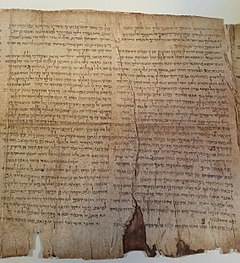Isaiah 15
Isaiah 15 is the fifteenth chapter of the Book of Isaiah in the Hebrew Bible or the Old Testament of the Christian Bible. This book contains the prophecies attributed to the prophet Isaiah, and is a part of the Book of the Prophets. This chapter and the following chapter deal with the forthcoming history of Moab.
| Isaiah 15 | |
|---|---|
 Photo of Great Isaiah Scroll facsimile, showing columns 12-13 (Isaiah 14:1-16:14). | |
| Book | Book of Isaiah |
| Hebrew Bible part | Nevi'im |
| Order in the Hebrew part | 5 |
| Category | Latter Prophets |
| Christian Bible part | Old Testament |
| Order in the Christian part | 23 |
Text
The original text was written in Hebrew language. This chapter is divided into 9 verses.
Textual witnesses
Some early manuscripts containing the text of this chapter in Hebrew are of the Masoretic Text tradition, which includes the Codex Cairensis (895), the Petersburg Codex of the Prophets (916), Aleppo Codex (10th century), Codex Leningradensis (1008).[1]
Fragments containing parts of this chapter were found among the Dead Sea Scrolls (3rd century BCE or later):[2]
- 1QIsaa: complete
- 1QIsab: extant verses 2-9
- 4QIsao (4Q68): extant verse 1
Extant ancient manuscripts of a translation into Koine Greek known as the Septuagint, made in the last few centuries BCE, include Codex Vaticanus (B; B; 4th century), Codex Sinaiticus (S; BHK: S; 4th century), Codex Alexandrinus (A; A; 5th century) and Codex Marchalianus (Q; Q; 6th century).[3]
Parashot
The parashah sections listed here are based on the Aleppo Codex.[4] Isaiah 15 is a part of the Prophecies about the Nations (Isaiah 13–23). {P}: open parashah; {S}: closed parashah.
- {P} 15:1-9 [16:1-4 {S}]
Verse 1
- The burden against Moab.
- Because in the night Ar of Moab is laid waste
- And destroyed,
- Because in the night Kir of Moab is laid waste
- And destroyed,[5]
- Because in the night Ar of Moab is laid waste
Verse 5
- My heart will cry out for Moab
Isaiah records his sympathy with Moab.[6]
See also
|
|
|
- Related Bible parts: 2 Kings 3, 2 Kings 13, Isaiah 13, Isaiah 14, Isaiah 16, Isaiah 25, Jeremiah 48, Ezekiel 25
Notes and references
- Würthwein 1995, pp. 35-37.
- Ulrich 2010, p. 360-361.
- Würthwein 1995, pp. 73-74.
- As reflected in the Jewish Publication Society's 1917 edition of the Hebrew Bible in English.
- Isaiah 15:1
- Cambridge Bible for Schools and Colleges on Isaiah 15, accessed 29 March 2018
![]()
Bibliography
- Ulrich, Eugene, ed. (2010). The Biblical Qumran Scrolls: Transcriptions and Textual Variants. Brill.CS1 maint: ref=harv (link)
- Würthwein, Ernst (1995). The Text of the Old Testament. Translated by Rhodes, Erroll F. Grand Rapids, MI: Wm. B. Eerdmans. ISBN 0-8028-0788-7. Retrieved January 26, 2019.CS1 maint: ref=harv (link)